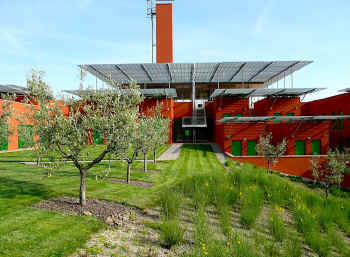
Super Tuscan wines |
|
Definition of "Super Tuscans"The rather foolish journalistic term "Super Tuscan wine" applies to Tuscan red wines of very high quality that do not adhere to traditional blending laws for the region or which have not been registered as doing so. For example, Chianti Classico wines were made from a blend of grapes with Sangiovese as the dominant varietal in the blend. Super Tuscans often used other grapes, especially cabernet sauvignon, making them ineligible for DOCG classification under the traditional rules. |
Rocca di Frassinello Winery
SassicaiaThe Marquis Mario Incisa della Rocchetta, on his Tenuta San Guido estate on the Tuscan coast, produced a wine consisting in large part of cabernet sauvignon. This wine was called Sassicaia and was considered so out of character for Tuscany that from 1948 to 1960 it was drunk only on the estate. In 1965, the Marquis planted two more vineyards with Cabernet Sauvignon and Cabernet Franc. The new “Sassicaia” vineyard was situated approximately 800 feet lower than the original Cabernet vineyard near Castiglioncello. The “Aianova” vineyard was slightly more elevated and more exposed to the weather. Eventually, all of the wine produced on the estate came to be known by the name of Sassicaia and the 1968 vintage of Sassicaia was the first to be offered on the open market. |
|
Tenuta Dell'OrnellaiaThe location of the Tenuta San Guido vineyards was also quite revolutionary, being located on the Tyrrhenian coast of the Maremma. Tenuta Dell'Ornellaia is another Super Tuscan vineyard located in the same area. It was founded by Lodovico Antinori, whose aunt Clarice della Gherardesca was the wife of Marchese Mario Incisa della Rocchetta. Lodovico Antonori's brother, Piero Antonori, had been consultant at Tenuta San Guido since the 1968 Sassicaia vintage. Tenuta Dell'Ornellaia was planted with Cabernet Sauvignon and Cabernet Franc, as well as Merlot and Sauvignon Blanc, and the first vintage was 1985. The wine proved highly successful. In 2002, Tenuta Dell'Ornellaia passed into ownership of the Mondavi family of California, who subsequently sold on 50% to the Italian Frescobaldi family and in 2005, sold their remaining 50% to Frescobaldi who now own Tenuta Dell'Ornellaia. These big names undoubtedly stimulated winery development on the Maremma coast to the extent that a "wine road" through the area is now promoted by the wine consortium. The Etruscan coast wine roadThis "wine road" starts with Montecatini Val di Cecina and continues through Montescudaia, Cecina, Bolgheri, Castagneto Carducci, Sassetta, Suvereto, Campiglia Marittima, Venturina and ends at the port of Piombino. On the island of Elba, there is a continuation that leads from Marina di Campo over the whole island as far as Rio Marina. Not all of the wines are red. There are also excellent whites such as Bianco della Val di Cornia (Suvereto) plus the Elban wines, the white Bianco L'Ansonica and the red Rosso Aleatico.
|
Antinori and Tignanello
In the 1970s, Piero Antinori, a relative of Mario Incisa della Rocchetta
and the descendant of an ancient winemaking family, inspired by the success of Sassicaia, decided to make a richer wine by eliminating the white grapes from the Chianti blend,
adding instead Bordeaux varietals (namely, cabernet sauvignon and merlot).
The result was a wine he named Tignanello, after the vineyard where the grapes were
grown, Santa Cristina estate (also known as Tenuta Tignanello) and located near Badia
a Passignano in the Chianti
Classico wine zone. Other winemakers started experimenting with
novel blends of their own shortly thereafter. Many were simply 100% Sangiovese
which could not be labelled Chianti Classico at the time. Recent legislation has
caught up with the producers and Chianti Classico may be produced solely from
Sangiovese. |
Super Tuscan wines |
|
Tuscan Wines Info © ammonet InfoTech 2006 - 2020. All rights reserved.